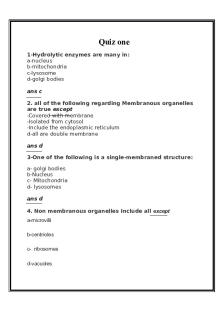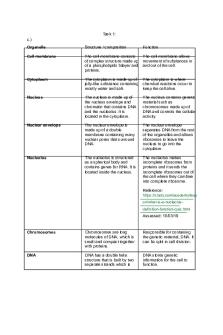Cell Fractionation - PPQs PDF

| Title | Cell Fractionation - PPQs |
|---|---|
| Author | jodi uril |
| Course | Cell Biology |
| Institution | Texas A&M University |
| Pages | 18 |
| File Size | 494.4 KB |
| File Type | |
| Total Downloads | 72 |
| Total Views | 133 |
Summary
PPQs...
Description
Feversham College
Q1.(a)
Describe and explain how cell fractionation and ultracentrifugation can be used to isolate mitochondria from a suspension of animal cells. ........................................................................................................................ ........................................................................................................................ ........................................................................................................................ ........................................................................................................................ ........................................................................................................................ ........................................................................................................................ ........................................................................................................................ ........................................................................................................................ ........................................................................................................................ ........................................................................................................................ (5)
(b)
Describe the principles and the limitations of using a transmission electron microscope to investigate cell structure. ........................................................................................................................ ........................................................................................................................ ........................................................................................................................ ........................................................................................................................ ........................................................................................................................ ........................................................................................................................ ........................................................................................................................ ........................................................................................................................ ........................................................................................................................ ........................................................................................................................ (5) (Total 10 marks)
Page 1
Feversham College
Q2.
(a) Small samples of plant tissue were placed in a cold, isotonic solution and then treated to break open the cells to release the organelles. The different organelles were then separated. Describe a technique that could be used to (i)
break open the cells; ............................................................................................................. .............................................................................................................
(ii)
separate the organelles. ............................................................................................................. ............................................................................................................. (2)
(b)
One group of organelles was placed in a hypotonic solution. The diagram shows one of these organelles seen under an electron microscope before and after it was placed in the hypotonic solution.
Name the organelle. ...................................................................................................................... (1)
(Total 3 marks)
Q3.
Read the following passage. In a human, there are over 200 different types of cell clearly distinguishable from each other. What is more, many of these types include a number of different varieties. White blood cells, for example, include lymphocytes and granulocytes.
5
10
Page 2
Although different animal cells have many features in common, each type has adaptations. associated with its function in the organism. As an example, most cells contain the same organelles, but the number may differ from one type of cell to another. Muscle cells contain many mitochondria, while enzyme-secreting cells from salivary glands have particularly large amounts of rough endoplasmic reticulum.
The number of a particular kind of organelle may change during the life of the cell. An example of this change is provided by cells in the tail of a tadpole. As a tadpole matures into a frog, its tail is gradually absorbed until it disappears completely. Absorption is associated with an increase in the number of lysosomes in the cells of the tail.
Feversham College
Use information from the passage and your own knowledge to answer the following questions. (a)
Explain the link between. (i)
mitochondria and muscle cells (lines 6 - 7); ............................................................................................................. ............................................................................................................. ............................................................................................................. ............................................................................................................. ............................................................................................................. (3)
(ii)
rough endoplasmic reticulum and enzyme-secreting cells from salivary glands (lines 7 - 8). ............................................................................................................. ............................................................................................................. ............................................................................................................. ............................................................................................................. (2)
(b)
Use information in the passage to explain how a tadpole’s tail is absorbed as a tadpole changes into a frog. ...................................................................................................................... ...................................................................................................................... ...................................................................................................................... ...................................................................................................................... (2)
(c)
Starting with some lettuce leaves, describe how you would obtain a sample of undamaged chloroplasts. Use your knowledge of cell fractionation and ultracentrifugation to answer this question. ...................................................................................................................... ...................................................................................................................... ...................................................................................................................... ...................................................................................................................... ...................................................................................................................... ...................................................................................................................... ......................................................................................................................
Page 3
Feversham College
...................................................................................................................... ...................................................................................................................... ...................................................................................................................... (6) (Total 13 marks)
Q4.
Liver was ground to produce a homogenate. The diagram shows how fractions containing different cell organelles were produced from the filtered homogenate.
(a)
Explain why the homogenate was filtered before spinning at low speed in the centrifuge. ...................................................................................................................... ...................................................................................................................... ...................................................................................................................... ......................................................................................................................
Page 4
Feversham College (2)
(b)
The main organelles present in sediment B were mitochondria. Suggest the main organelles present in (i)
sediment A; ............................................................................................................. (1)
(ii)
sediment C. ............................................................................................................. (1)
(c)
What property of cell organelles allows them to be separated in this way? ...................................................................................................................... ...................................................................................................................... (1)
(d)
Explain why the organelles in sediment C could be seen with a transmission electron microscope but not with an optical microscope. ...................................................................................................................... ...................................................................................................................... ...................................................................................................................... ...................................................................................................................... (2) (Total 7 marks)
Q5.(a)
Describe how you could make a temporary mount of a piece of plant tissue to observe the position of starch grains in the cells when using an optical (light) microscope. ........................................................................................................................ ........................................................................................................................ ........................................................................................................................ ........................................................................................................................ ........................................................................................................................ ........................................................................................................................ ........................................................................................................................ ........................................................................................................................ (Extra space) ................................................................................................ ........................................................................................................................ ........................................................................................................................ (4)
Page 5
Feversham College
The figure below shows a microscopic image of a plant cell.
© Science Photo Library
(b)
Give the name and function of the structures labelled W and Z. Name of W ....................................................................................................... Function of W ................................................................................................... Name of Z ........................................................................................................ Function of Z .................................................................................................... (2)
(c)
A transmission electron microscope was used to produce the image in the figure above. Explain why. ........................................................................................................................ ........................................................................................................................ ........................................................................................................................ ........................................................................................................................ ........................................................................................................................ (2)
(d)
Page 6
Calculate the magnification of the image shown in the figure in part (a).
Feversham College
Answer = ................................... (1) (Total 9 marks)
Q6.
The diagram shows how some organelles may be distinguished from each other.
Organelle found in prokaryotic and eukaryotic cells Organelle A
Organelle found only in eukaryotic cells
Organelle found in animal cells and in plant cells. Does not contain membranes arranged in stacks.
Larger organelle surrounded by an envelope through which there are pores. usually one per cell. Organelle C (a)
(i)
Organelle found in plant cells. Contains inner membranes arranged in stacks. Organelle B
Smaller organelle surrounded by an outer membrane. Has an inner membrane, folded to form cristae. Many in the cell. Organelle D
Name organelle B. ............................................................................................................. (1)
(ii)
Describe the function of organelle B. ............................................................................................................. ............................................................................................................. ............................................................................................................. ............................................................................................................. (2)
(b)
Which of organelles A, B, C or D (i)
is a ribosome; ............................................................................................................. (1)
(ii)
contains most of the DNA found in a plant cell? ............................................................................................................. (1)
(c)
Page 7
Some liver tissue was ground, filtered and centrifuged to make a suspension of
Feversham College
organelle D. (i)
Explain why the solution in which the liver tissue was ground should be ice-cold. ............................................................................................................. ............................................................................................................. (1)
(ii)
The ground liver was centrifuged at low speed. The pellet that formed at the bottom of the centrifuge tube was thrown away and the supernatant centrifuged again at higher speed. Explain why it was necessary to first centrifuge the ground liver at low speed in order to obtain a suspension of organelle D. ............................................................................................................. ............................................................................................................. ............................................................................................................. ............................................................................................................. (2) (Total 8 marks)
Q7.
(a)
Name the type of bond that joins amino acids together in a polypeptide.
...................................................................................................................... (1)
The diagram shows a cell from the pancreas.
(b)
Page 8
The cytoplasm at F contains amino acids. These amino acids are used to make proteins which are secreted from the cell.
Feversham College
Place the appropriate letters in the correct order to show the passage of an amino acid from the cytoplasm at F until it is secreted from the cell as a protein at K.
F
K (2)
(c)
There are lots of organelle G in this cell. Explain why. ...................................................................................................................... ...................................................................................................................... ...................................................................................................................... ...................................................................................................................... (2)
(d)
A group of scientists homogenised pancreatic tissue before carrying out cell fractionation to isolate organelle G. Explain why the scientists (i)
homogenised the tissue ............................................................................................................. ............................................................................................................. (1)
(ii)
filtered the resulting suspension ............................................................................................................. ............................................................................................................. (1)
(iii)
kept the suspension ice cold during the process ............................................................................................................. ............................................................................................................. (1)
(iv)
used isotonic solution during the process. ............................................................................................................. ............................................................................................................. ............................................................................................................. ............................................................................................................. (2) (Total 10 marks)
Page 9
Feversham College
Q8.A stomach ulcer is caused by damage to the cells of the stomach lining. People with stomach ulcers often have the bacterium Helicobacter pylori in their stomachs. A group of scientists was interested in trying to determine how infection by H. pylori results in the formation of stomach ulcers. The scientists grew diff...
Similar Free PDFs

Cell Fractionation - PPQs
- 18 Pages

cell fractionation
- 6 Pages

Cell mitosis - cell mitotsis
- 4 Pages

Cell Biology Quiz CELL ORGANELLES
- 10 Pages

2 - Cell & Cell Division & Epithelia
- 30 Pages

Cell respiration
- 6 Pages

Cell Communication
- 16 Pages

Cell biology
- 3 Pages

1. CELL
- 36 Pages

Cell rap
- 3 Pages
Popular Institutions
- Tinajero National High School - Annex
- Politeknik Caltex Riau
- Yokohama City University
- SGT University
- University of Al-Qadisiyah
- Divine Word College of Vigan
- Techniek College Rotterdam
- Universidade de Santiago
- Universiti Teknologi MARA Cawangan Johor Kampus Pasir Gudang
- Poltekkes Kemenkes Yogyakarta
- Baguio City National High School
- Colegio san marcos
- preparatoria uno
- Centro de Bachillerato Tecnológico Industrial y de Servicios No. 107
- Dalian Maritime University
- Quang Trung Secondary School
- Colegio Tecnológico en Informática
- Corporación Regional de Educación Superior
- Grupo CEDVA
- Dar Al Uloom University
- Centro de Estudios Preuniversitarios de la Universidad Nacional de Ingeniería
- 上智大学
- Aakash International School, Nuna Majara
- San Felipe Neri Catholic School
- Kang Chiao International School - New Taipei City
- Misamis Occidental National High School
- Institución Educativa Escuela Normal Juan Ladrilleros
- Kolehiyo ng Pantukan
- Batanes State College
- Instituto Continental
- Sekolah Menengah Kejuruan Kesehatan Kaltara (Tarakan)
- Colegio de La Inmaculada Concepcion - Cebu





